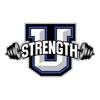|
The current definition of agility is “a rapid whole-body movement with change of velocity or direction in response to rich information”. Coaches often miss the change of speed element and think the fastest response is always best. This is typically not the case, at The U of Strength we teach our athletes that they need to control their speed. This will allow them to respond to relevant information with an appropriate response and solution. The ability to quickly decelerate and under control is essential for athletic success.
Another important part of agility training that is often overlooked is the connection between the perceptual and cognitive processes. The quality of an athlete’s movement will be directly related to the quality of decisions made. We promote, the athletes who can quickly make effective decisions will likely gain a step on their opponent, even if there’s a difference with physical abilities (speed, strength and power). The cognitive components are organized into 2 different categories:
Here are some progressions we follow to facilitate the ability of being under control and making effective decisions: 1. Increasing the work space
0 Comments
Leave a Reply. |
Details
AuthorJamie Smith is a proud husband and father, passionate about all things relating to athletic development and a life long learner, who is open to unorthodox ideas as long they are beneficial to his athletes. Categories |
Services |
The Gym |
|
Tel: (860) 833-9366
Email: theuofstrength@gmail.com
*By accessing this website and/or purchasing or utilizing the articles, emails, programs, images, videos, services and/or products, you are agreeing to this disclaimer in its entirety. The content on this website and the educational products sold within are the intellectual property of The U of Strength, LLC and may not be replicated, reproduced, or sold without prior written consent from The U of Strength, LLC. Website, social media and product content provided is for informational purposes and meant to be utilized by athletes, sport coaches, and fitness professionals at their own discretion. It is not meant to substitute advice or guidance from qualified medical experts, and misuse of the information can result in serious injury. Any fitness program should be administered under the discretion of qualified professionals who take into account individual differences in health and ability. While our programs have found success with the athletes who train at our facility, individual results vary and we do not guarantee any specific results. The U of Strength, LLC assumes no liability from the misuse of the content provided or products purchased. Users assume all risk when implementing our ideas in theirs or their clients’ real life training experiences.
Email: theuofstrength@gmail.com
*By accessing this website and/or purchasing or utilizing the articles, emails, programs, images, videos, services and/or products, you are agreeing to this disclaimer in its entirety. The content on this website and the educational products sold within are the intellectual property of The U of Strength, LLC and may not be replicated, reproduced, or sold without prior written consent from The U of Strength, LLC. Website, social media and product content provided is for informational purposes and meant to be utilized by athletes, sport coaches, and fitness professionals at their own discretion. It is not meant to substitute advice or guidance from qualified medical experts, and misuse of the information can result in serious injury. Any fitness program should be administered under the discretion of qualified professionals who take into account individual differences in health and ability. While our programs have found success with the athletes who train at our facility, individual results vary and we do not guarantee any specific results. The U of Strength, LLC assumes no liability from the misuse of the content provided or products purchased. Users assume all risk when implementing our ideas in theirs or their clients’ real life training experiences.

 RSS Feed
RSS Feed